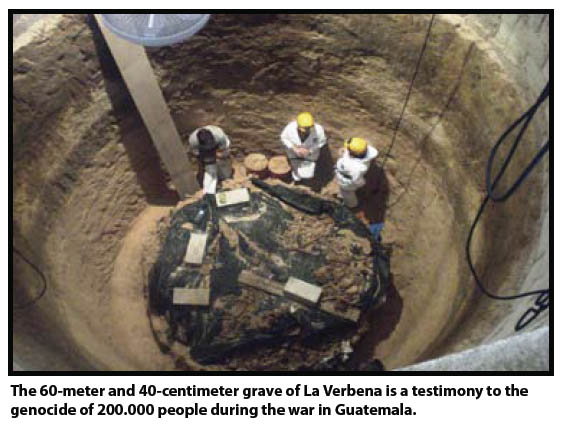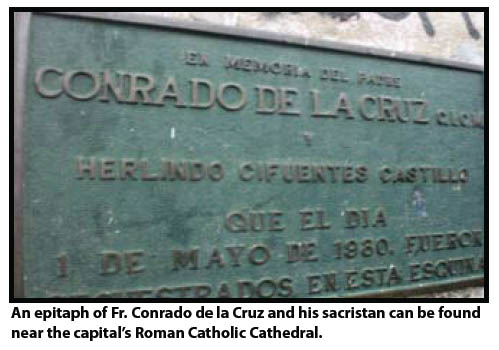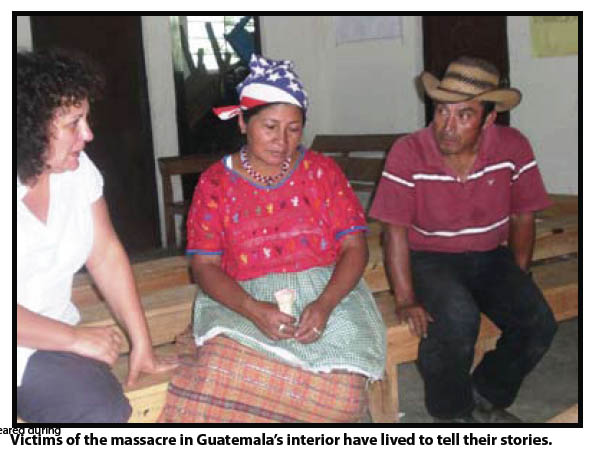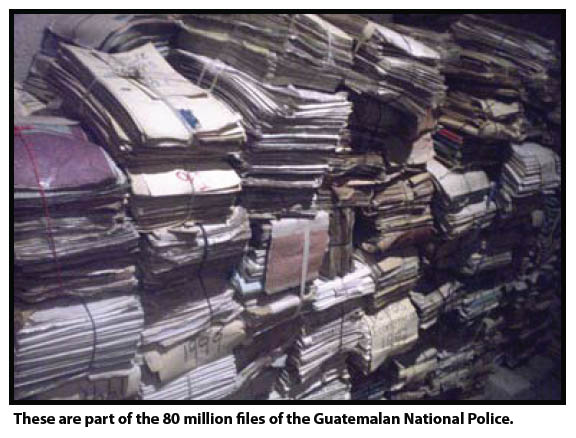Trekking Latin American Terrains
in the Pursuit of Truth and Justice…
by Mary Aileen D. Bacalso
The Asian-Latin American Cooperation on the Phenomenon of Enforced
Disappearances
“El pueblo, unido, jamas, sera’ vencido!”
is the slogan which we, in the Philippines, repeatedly chanted when we
invited representatives from the Asociacion Pro Búsqueda de Ninas y
Ninos Desaparecidos of El Salvador and the H.I.J.O.S. of
Argentina respectively to the 1997 commemoration of the International
Week of the Disappeared by the Families of Victims of Involuntary
Disappearance (FIND). From the inspiration of the Latin American
families’ establishment of the Latin American Federation of Associations
of Relatives of Disappeared-Detainees (FEDEFAM), the Asian Federation
Against Involuntary Disappearances (AFAD) was born and has now become
the only regional federation in Asia which has united in one common
direction eleven member-organizations working directly on enforced
disappearances. Its solidarity has made a difference in the lives of the
families of the disappeared.
The cooperation between the AFAD and the FEDEFAM has flourished and
grown during the last twelve years through their mutual support at the
United Nations during and beyond the drafting process of the UN
Convention for the Protection of All Persons from Enforced Disappearance
(The Convention) and recently in various Asian countries in the campaign
for the signing and ratification of the said Convention.
One of the recent manifestations of cooperation was the First Asian
Conference on Psychosocial Work for the Search of Enforced Disappeared
Persons in Exhumation Processes and the Struggle for Truth and Justice.
It was convened on 8-11 November 2009 in Manila, Philippines through the
AFAD’s cooperation with the Equipo de Estudios Comunitarios y Acción
Psicosocial (ECAP) and GEZA.
This conference was part of the preparations for the Second World
Conference on Psychosocial Work in Enforced Disappearance and
Exhumation, Justice and Truth Processes held in Bogota, Colombia on 2123
April 2010. During which, this author was invited to speak on challenges
for lobbying on the Minimum Principles and Standards for Psychosocial
Work in Cases of Enforced Disappearance, Arbitrary and Extrajudicial
Executions and Forensic Investigations on Serious Human Rights
Violations and on the Philippine organizations’ responses to enforced
disappearances in the country.
 With
an atmosphere of impunity looming in almost, if not all Asian countries
where disappearances prevail, these activities serve as a foundation for
the continuing struggle to search for the truth, to obtain justice and
redress and to reconstruct the historical memory. It is important to
take into consideration the empowerment of families of the disappeared,
who have to muster their inner resources which they might not have
recognized because of the impact of the loss.
With
an atmosphere of impunity looming in almost, if not all Asian countries
where disappearances prevail, these activities serve as a foundation for
the continuing struggle to search for the truth, to obtain justice and
redress and to reconstruct the historical memory. It is important to
take into consideration the empowerment of families of the disappeared,
who have to muster their inner resources which they might not have
recognized because of the impact of the loss.
The wealth of experience in Latin America in searching for the
disappeared and in prosecuting the perpetrators is worth imitating,
notwithstanding that Latin America and Asia have different social and
political contexts.
After all, as the mothers and grandmothers of Argentina always assured
their Asian counterpart, “ estamos en el mismo dolor, en la misma
lucha, en la misma esperanza y en la misma victoria.2”
Trekking Latin American Terrains
From the Southern Cone, this author was also invited by ECAP for
a 16-day interchange of experience in Guatemala from 23 April - 8 May
2010. She revisited the war-ravaged República de Guatemala. A
small country of 108,890 km² (42,043 mi²) with an estimated population
of 13,276,517, Guatemala has 45,000 desaparecidos and approximately
200,000 assassinated. This occurred in the context of the longest civil
war in Latin American history, running from 1960-1996 due to land
conflicts resulting in an armed conflict between the guerilla movements
and the Guatemalan military.
The Use of Forensic Science as a Foundation for Truth and Justice
Arriving Guatemala City on 25 April from the 6-hour flight from
Colombia, the author took a day off to prepare for the half-month
exposure.
Immediately, at the start of the long week, she was quickly introduced
to ECAP by her host, Mr. Franc Kernjak and led to the Office of
the Fundación de Antropologia Forense de Guatemala3,
a nongovernmental autonomous, technical-scientific, non-profit
organization that contributes to the strengthening of the justice
system. The foundation aims to respect human rights through the
investigation, documentation, dissemination, education and awareness
raising on human rights violations and cases of non-clarified deaths4.
The Assistant Director, Jose Suasnavar explained that the foundation was
established in 1992 as a response to the request of victims of the armed
conflict. It aims to know the magnitude of the massacres and to find the
remains of the victims. This Guatemalan foundation was the third
forensic team formed in Latin America after the establishment of the
Argentine and the Chilean forensic anthropology teams. After the
dictatorship, it began its work.
The use of forensic anthropology is an integral part of the search for
justice. It is the anthropologists’ function to help the fiscal in the
investigation and seeks to establish the cause of the death and the
identity of the disappeared persons. It aims to identify the remains and
the cause of death. The families’ testimonies are crucial. They are
witnesses to the whole process of forensic investigation, which goes
beyond identification of skeletal remains and their return to their
families for reburial. The process continues up to criminal
investigation of the perpetrators to obtain truth and justice. In all
these, 93 percent of the victims underwent a process of psycho-social
support to prevent re-traumatization and facilitate empowerment.
The Foundation showed its DNA5
laboratory, where the anthropologists very ably explained its 99.99
percent accuracy. It also presented the process of identifying skeletal
remains which were in the process of identification and eventual return
to their families.
 The
visit was informative not only in terms of the scientific value of
forensic science but also indicating the horrible effects of war. How
victims and perpetrators can live in the same communities without
reconciliation because justice has not been served was elucidated based
on the anthropologists’ integration with the people in the communities.
To simply illustrate an example of painful post war realities, a victim
pleading to a perpetrator to turn on the water could be very revolting.
The
visit was informative not only in terms of the scientific value of
forensic science but also indicating the horrible effects of war. How
victims and perpetrators can live in the same communities without
reconciliation because justice has not been served was elucidated based
on the anthropologists’ integration with the people in the communities.
To simply illustrate an example of painful post war realities, a victim
pleading to a perpetrator to turn on the water could be very revolting.
The long day ended with a mass at the Guatemalan Cathedral commemorating
the anniversary of the brutal murder of Bishop Juan Gerardi, 75, beaten
to death in the garage of the rectory where he lived just two days after
a commission he headed released a report documenting 55,000 human rights
violations during Guatemala’s civil war, most of which were committed by
the army.
Little did this author know that near the Cathedral, engraved are names
of Fr. Conrado de la Cruz, CICM and Herlindo Cifuentes Castillo who
disappeared on 1 May 1980 in that particular place. Fr. de la Cruz, a
Filipino priest, disappeared with his sacristan in Guatemala 30 years
ago. They have never been found.
Finding Skeletons Inside the Closet as an Integral Part of Forensic
Science
Mi Nombre no Es XX
6
is a campaign calling on all Guatemalans who have loved ones who
disappeared to give blood and saliva samples to be matched with skeletal
remains. With an education drive at the community level, indigenous
peoples who, by their culture, cannot easily give a part of themselves
as samples for DNA tests, are being encouraged to give blood and saliva
samples leading to the identification of skeletal remains because of
their very accuracy as means of identification. The process has not
always been smooth and necessitates patience especially on the part of
the families who may have to wait for a long time before results can be
known.
Making the visit to the Foundation more concrete was a follow up visit,
this time in the cemetery of La Verbena . The entrance to the cemetery
of La Verbena sported a big streamer that states: “Con tu muestra de
ADN es posible identificar a tu familiar desaparecido durante el
Conflicto Armado Interno. La toma de muestra es gratis y confidencial.7”
A lady anthropologist explained the campaign and showed a mass grave
with a depth of 60 meters and 40 centimeters. The forensic people had
already discovered 3,177 remains buried during various periods of the
war in that same grave. Some of them had identification cards. Others
brought rosaries. Some still had personal effects on them. Others were
tortured and died slow deaths while many were shot dead with bullets
remaining in their skeletons and a significant number may have just died
of hunger. Several women were allegedly raped.
I was encouraged by the anthropologist to enter into the grave. I did
not think that I could do it. But I did. Deep down into the grave, I
personally witnessed the continuous digging and saw the broken bones of
people who most certainly had names, lives to live and families to love
and cherish, but were mercilessly murdered in the name of national
security.
MEETINGS WITH CIVIL SOCIETY ORGANIZATIONS
Civil society organizations in Guatemala are very much alive. Not bereft
of internal dynamics, they are not necessarily homogenous. Despite their
diversity, the work of each one contributes to that of the others.
Liga Guatemalteca de Higiene Mental
The Liga Guatemalteca de Higiene Mental is an eleven-year old
organization that searches for disappeared children during the war. It
found 300 children in different countries whose identities had been
changed. With the search for these children, the organization is
facilitating their reunification with their biological parents. For more
than a decade, the organization, in its contribution to the construction
of peace, has struggled against forgetting and has overcome silence.
It was an honor to have met with the local organizers who took charge of
taking care of families of victims. So kind was the Liga that it
organized a press conference for this author to present the Asian
phenomenon of enforced disappearances and her federation’s solidarity
with the Guatemalan organizations. Moreover, it bestowed a plaque of
appreciation to her for her global work against disappearances.
FAMDEGUA
FAMDEGUA,
a group of women family members of the disappeared, started organizing
themselves in 1984. Two women in the office told me a story of an
incident in December of 1982 when the army was looking for arms, but
found nothing. They took men, women and children to a school where all
the adults were killed and the children left alive.
“We were looking for survivors. We found a soldier, who was five years
old then when the massacre occurred. His mother was killed. He was
whiteskinned, with clear eyes. We found witnesses who told the names of
17 military men. This guy, a survivor of the massacre, was put in the
army service. We did everything to advise him to leave the army and the
country. He saw the killing of his 6 brothers. Some said that a
five-year old child cannot remember what happened. But he vividly
remembered what happened during the war. Fortunately, the judge took the
testimony.
We had to present the case to the Inter-American Commission of Human
Rights. The investigation was very exhaustive. The sentence was very
good , i.e. to exhume the victims’ remains and have them identified by
DNA. There is an investigation, judgment and punishment for the
perpetrators. On 9 February, they captured the two perpetrators. We have
small steps and these are our sources of hope.”

Grupo de Apoyo Motuo (GAM)
I have known GAM since 1997, during the 14th Congress of
FEDEFAM held in Mexico City in November 1997 and its succeeding
Congresses, one of which it hosted in 2003.
The GAM started in 1989. Its tasks include, among others, making
the armed forces accountable for the 440 massacres during the period. It
was then that GAM shared the case of Fr. de la Cruz, whose
details were provided to me so that I could facilitate coordination
between the priest’s family in the Philippines and the GAM. The
case is still open as one of the 102 cases of disappearances filed in
court.
GAM
is organizing and training 42,000 families from 381 communities and 18
departments. It focuses on accompaniment program for victims, e.g.
psychosocial rehabilitation; establishment of new members from women and
the youth and legal work. GAM also facilitates socio-economic
projects. Another aspect of the work focuses on gender, particularly on
victims of sexual violence.
The GAM shared that in its integration with the Mayans, the
latter invoke their gods and give thanks to the land, the heavens, the
sun and ask mother earth to exhume and rebury their dead. The Mayans do
not believe that the disappeared are dead.
ECAP
The six years of war was the inspiration for the program, Diplomada
Salud Mental Comunitaria. 2002 was the first promotion of the
diplomado. So far, 151 men and women have graduated.
One lady beneficiary shared how the program has helped her.
“It helped me a lot. We realize that we also have the right to live in
peace. We had no opportunity to go to school because our parents did not
bring us to school. It is important to help other people. My community
work is important. I am a midwife. I have the opportunity to practice my
profession with couples. To give counsel to the couples, especially the
women is important and gratifying. I thank God because He is the only
one who gives us life. I thank ECAP. What is important is that in the
diplomado, there are persons from different places, with different
customs. You learn to trust other people.”

A diplomado instructor shared:
“We discovered that dreams are bridges of the one that disappeared. We
had success with women who do not have the remains of their husbands. It
was a way of communicating with the dead. It is important to work within
the spaces and time that these persons have. In the dream, was the
person dead or alive? One part of us says that our disappeared are
alive. Another part says that they are dead. It is a symbol of the
connection between death and life. The disappeared people do not have to
have a body in order for you to communicate with them.”
The ECAP also arranged my visit to Rabinal, where I was humbled
by the organizing work of the local team. Fernando, Erlinda Corazon,
Fabian, Eduardo, Diego, Fabian, Manuel Roman – each of them contributes
in carrying out the three projects of the organization, e.g.
accompaniment in the exhumation process; accompaniment to torture
victims and torture prevention; strengthening of the community.
The visit brought me to various graves and memorials of massacre victims
where names of heroes and martyrs are engraved. What was striking is the
Catholicism of many and the emergence of other religions, thus, further
driving a wedge to an already divided population.
Victims shared the horrors of the massacres and their consequences, the
absence of truth and justice and the strong resolve to obtain them. A
late night meeting with Jesus Tecu, who was only ten years old during
the Rio Negro massacre on 13 March 1982, told the story of sufferings,
of pain and of tears. This author read his book, “ Memoria de las
Masacres de Rio Negro: Recuerdo de mis Padres y Memoria Para Mis Hijos
8.”
He witnessed the killings of men and women in Rio Negro, including those
of his own immediate family. In vain, he pleaded for his two-year old
brother’s life. He began to conduct legal proceedings to have the mass
grave of Rio Grande exhumed, leading to the prosecution of three of the
perpetrators.
The Archives – A Strong Evidence of the Truth
Mr. Alberto Fuentes, who shared the work on the archives of the Police
in Guatemala, toured me through the voluminous files which are concrete
evidence to the genocide of 200,000 people. He affirmed that the police
was one of the institutions that executed people. Thus, it was important
to investigate the human rights violations it committed through access
to its archives.
The government denied that the archives existed. The person who made the
inspection saw many documents. He entered a door and asked for these
documents. The lady affirmatively answered that the documents belonged
to the national police. The archives are huge, containing 80 million
files.
The archives are being digitized, but because of their huge volume, only
10 million files have thus far been digitized during the last five years
by 150 persons. The archives are facing the risk of a lack of security
for the documentation; the danger of being destroyed by water during
rainy days and the darkness of the building. There is a process to get
rid of rats and insects that could also destroy the documents.
In the documentation, there is evidence on how the army worked and
cooperated with the police. The anti-insurgency operations and
intelligence work are obvious in the documents. They put the remains in
the cemeteries which people called, XX. In those detailed reports, there
are signs of torture, mutilations, strangulation, sexual violence, but
this information has disappeared. The reports state that the common
cause of death was cardiac arrest.
The following are four important lines of work on the archives:
1. Recuperating the documents that are in bad condition;
2. Organizing the archived documents and arranging them alphabetically
and numerically;
3. Determining sources of information;
4. Developing a macro investigation in trying to determine the persons
who perpetrated the act, the chain of command and the changes in the
structures.
Revisiting El Salvador
El Salvador is a three-hour ride by car from Guatemala. Together with an
ECAP team of lady pychologists, the author revisited nearby El
Salvador. Revisiting Fr. Jon Cortina’s parish, now a museum in Guarjila,
Chalatenango was part of the journey. Fr. Cortina, S.J. facilitated the
cooperation between AFAD and FEDEFAM in 1997.
It was also an opportunity to visit the Universidad Centro Americana (UCA)
where 6 Jesuits and their two lady helpers were massacred by members of
the Salvadorean Armed Forces. In was also in their common grave in the
UCA chapel that Fr. Jon’s remains were buried.
The visit allowed the renewal of ties between AFAD and the Asociación
Pro Búsqueda de Niñas y Niños Desaparecidos.
And tears and blood have been turned into courage…
For every drop of blood, a victory in the name of truth and justice…Our
Latin American sisters and brothers found many disappeared children.
They work for prosecution of perpetrators. In the process, they are
constructing genuine and lasting peace.
Trekking bloody terrains of these Latin American countries, I salute our
Latin American sisters and brothers for their courage, their persistence
and determination to ferret out the truth and to pursue the struggle for
justice at all costs.
These are sources of inspiration to us here in Asia as we envision a
world without desaparecidos.
“Venceremos!9”
Notes:
1 Its English
translation : “ The people, united shall never be defeated!”
2 “We are one in
the same pain, in the same struggle, in the same hope and in the same
victory.
3 Guatemalan
Forensic Anthropology Foundation
4 Source:
http://www.fafg.com
5 Deoxyribonucleic
acid or DNA is a nucleic acid that contains the genetic instructions
used in the development and functioning of all known living organisms
(with the exception of RNA viruses. The main role of DNA molecules is
the long-term storage of information. DNA is often compared to a set of
blueprints, like recipe or a code, since it contains the instructions
needed to construct other components of cells, such as proteins and RNA
molecules. The DNA segments that carry this genetic information are
called genes, but other DNA sequences have structural purposes, or are
involved in regulating the use of this genetic information. Accessed
from www. wikipedia.org on 28 February 2011.
6 “My name is not
XX.”
7
With your DNA sample, it is possible to identify your family member who
disappeared during Victims of the massacre in Guatemala’s interior have
lived to tell their stories. the Internal Armed Conflict. Taking your
sample is free and confidential.
8 Memory of the
Massacres of Rio Negro, In Memory of My Parents and Memory for My
Children.
9 “We shall
overcome.”

Mary Aileen Diez-Bacalso is currently the SecretaryGeneral of the AFAD.
She has been recently elected as the new focal person of the
International Coalition Against Enforced Disappearances. One of her
outstanding contributions to the fight against impunity was her active
participation in the threeyear drafting and negotiation process of the
UN Convention for the Protection of All Persons from Enforced
Disappearance in Geneva, Switzerland from 2003-2005. She has also been
nominated by the Government of the Philippines as independent observer
for the Peace Process between the Government of the Philippines and the
National Democratic Front.